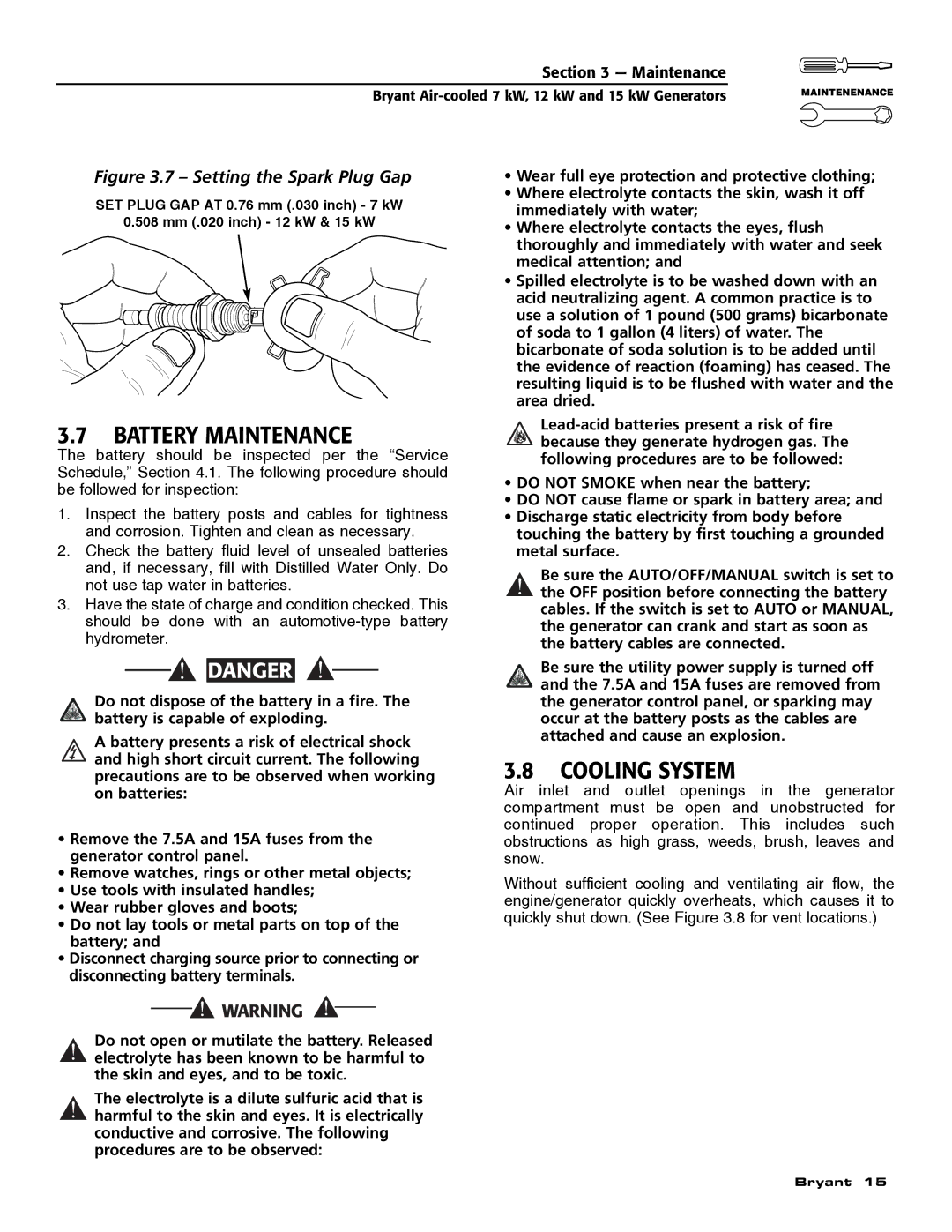
Section 3 — Maintenance
Bryant
MAINTENENANCE
Figure 3.7 – Setting the Spark Plug Gap
SET PLUG GAP AT 0.76 mm (.030 inch) - 7 kW
0.508 mm (.020 inch) - 12 kW & 15 kW
3.7BATTERY MAINTENANCE
The battery should be inspected per the “Service Schedule,” Section 4.1. The following procedure should be followed for inspection:
1.Inspect the battery posts and cables for tightness and corrosion. Tighten and clean as necessary.
2.Check the battery fluid level of unsealed batteries and, if necessary, fill with Distilled Water Only. Do not use tap water in batteries.
3.Have the state of charge and condition checked. This should be done with an
![]()
![]() DANGER
DANGER
Do not dispose of the battery in a fire. The battery is capable of exploding.
A battery presents a risk of electrical shock and high short circuit current. The following precautions are to be observed when working on batteries:
•Remove the 7.5A and 15A fuses from the generator control panel.
•Remove watches, rings or other metal objects;
•Use tools with insulated handles;
•Wear rubber gloves and boots;
•Do not lay tools or metal parts on top of the battery; and
•Disconnect charging source prior to connecting or disconnecting battery terminals.
Do not open or mutilate the battery. Released
!electrolyte has been known to be harmful to the skin and eyes, and to be toxic.
The electrolyte is a dilute sulfuric acid that is
!harmful to the skin and eyes. It is electrically conductive and corrosive. The following procedures are to be observed:
•Wear full eye protection and protective clothing;
•Where electrolyte contacts the skin, wash it off immediately with water;
•Where electrolyte contacts the eyes, flush thoroughly and immediately with water and seek medical attention; and
•Spilled electrolyte is to be washed down with an acid neutralizing agent. A common practice is to use a solution of 1 pound (500 grams) bicarbonate of soda to 1 gallon (4 liters) of water. The bicarbonate of soda solution is to be added until the evidence of reaction (foaming) has ceased. The resulting liquid is to be flushed with water and the area dried.
•DO NOT SMOKE when near the battery;
•DO NOT cause flame or spark in battery area; and
•Discharge static electricity from body before touching the battery by first touching a grounded metal surface.
Be sure the AUTO/OFF/MANUAL switch is set to ! the OFF position before connecting the battery cables. If the switch is set to AUTO or MANUAL,
the generator can crank and start as soon as the battery cables are connected.
Be sure the utility power supply is turned off and the 7.5A and 15A fuses are removed from the generator control panel, or sparking may occur at the battery posts as the cables are attached and cause an explosion.
3.8COOLING SYSTEM
Air inlet and outlet openings in the generator compartment must be open and unobstructed for continued proper operation. This includes such obstructions as high grass, weeds, brush, leaves and snow.
Without sufficient cooling and ventilating air flow, the engine/generator quickly overheats, which causes it to quickly shut down. (See Figure 3.8 for vent locations.)
Bryant 15
